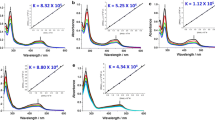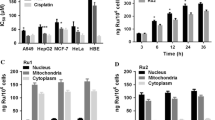Abstract
The dichlorobis(2-phenylazopyridine)ruthenium(II) complexes, [Ru(azpy)2Cl2], are under renewed investigation due to their potential anticancer activity. The three most common isomers α-, β- and γ-[RuL2Cl2] with L=o-tolylazopyridine (tazpy) and 4-methyl-2-phenylazopyridine (mazpy) (α indicating the coordinating Cl, N(pyridine) and Nazo atoms in mutual cis, trans, cis positions, β indicating the coordinating Cl, N(pyridine) and Nazo atoms in mutual cis, cis, cis positions, and γ indicating the coordinating Cl, N(pyridine) and Nazo atoms in mutual trans, cis, cis positions) are synthesized and characterized by NMR spectroscopy. The molecular structures of γ-[Ru(tazpy)2Cl2] and α-[Ru(mazpy)2Cl2] are determined by X-ray diffraction analysis. The IC50 values of the geometrically isomeric [Ru(tazpy)2Cl2] and [Ru(mazpy)2Cl2] complexes compared with those of the parent [Ru(azpy)2Cl2] complexes are determined in a series of human tumour cell lines (MCF-7, EVSA-T, WIDR, IGROV, M19, A498 and H266). These data unambiguously show for all complexes the following trend: the α isomer shows a very high cytotoxicity, whereas the β isomer is a factor 10 less cytotoxic. The γ isomers of [Ru(tazpy)2Cl2] and [Ru(mazpy)2Cl2] display a very high cytotoxicity comparable to that of the γ isomer of the parent compound [Ru(azpy)2Cl2] and to that of the α isomer. These biological data are of the utmost importance for a better understanding of the structure–activity relationships for the isomeric [RuL2Cl2] complexes.






Similar content being viewed by others
Notes
In the C2, symmetric γ and α isomers of the [Ru(azpy)2Cl2] complexes, the two azpy ligands are equivalent. Therefore, it is not clear beforehand whether an NOE is an (intramolecular) inter- or intraligand NOE cross-peak. However, the NOE H6–H(o) in the α isomer of α-[Ru(azpy)2Cl2] is definitely an interligand one, for example. Obviously from the distance H6–H(o) within one azpy ligand of α-[Ru(azpy)2Cl2], as derived from the X-ray structure [35] (on average 6.31 Å), it is clear that no intraligand NOE can be expected. The interligand H6–H(o) distance, as shown in the X-ray structure, is on average 4.14 Å, predicting the interligand NOE. Moreover, in asymmetric α-isomeric azpy complexes [37], like α-[Ru(azpy)2(9-Egua)(H2O)](PF6)2 or α-[Ru(azpy)2Cl(NO3)] (unpublished data), the interligand H6–o’ and H6’–o (prime denoting the other azpy ligand) are observed and not, for example, the intraligand H6–o NOE.
Abbreviations
- AAS:
-
atomic absorption spectroscopy
- azpy:
-
2-phenylazopyridine
- COSY:
-
correlation spectroscopy
- mazpy:
-
4-methyl-2-phenylazopyridine
- MTT:
-
3-(4,5-dimethylthiazol-2-yl)-2,5-diphenyl-2H-tetrazolium bromide
- NOESY:
-
nuclear Overhauser-effect spectroscopy
- PBS:
-
phosphate-buffered saline
- tazpy:
-
o-tolylazopyridine
References
Clarke MJ, Zhu FC, Frasca DR (1999) Chem Rev 99:2511–2533
Clarke MJ (2002) Coord Chem Rev 232:69–93
Reedijk J (2003) Proc Natl Acad Sci USA 100:3611–3616
Lippert B (ed) (1999) Cisplatin. chemistry and biochemistry of a leading anticancer drug. Verlag Helvetica Chimica Acta, Zurich, Wiley-VCH, Weinheim
Wong E, Giandomenico CM (1999) Chem Rev 99:2451–2466
Van Vliet PM (1996) PhD Thesis, Leiden University, The Netherlands
Nováková O, Kaspárková J, Vrána O, Van Vliet PM, Reedijk J, Brabec V (1995) Biochemistry 34:12369–12378
Velders AH, Kooijman H, Spek AL, Haasnoot JG, de Vos D, Reedijk J (2000) Inorg Chem 39:2966–2967
Goswami S, Chakravarty AR, Chakravorty A (1981) Inorg Chem 29:2246–2250
Krause RA, Krause K (1980) Inorg Chem 19:2600–2603
Velders AH, Van der Schilden K, Hotze ACG, Reedijk J, Kooijman H, Spek AL (2004) J Chem Soc Dalton Trans 448–455
Popov AM, Egorova MB, Lutovinov VA, Dmitrieva RI (1990) Zh Obshch Khim 60:2169
Goswami S, Mukherjee R, Chakravorty A (1983) Inorg Chem 22:2825–2832
Goswami S, Chakravarty AR, Chakravorty A (1983) Inorg Chem 11:602–609
Bag N, Pramanik A, Lahiri GK, Chakravorty A (1992) Inorg Chem 31:40–45
Ackermann MN, Kiihne SR, Saunders PA, Barnes CE, Stallings SC, Kim HD, Woods C, Lagunoff M (2002) Inorg Chim Acta 334:193–203
Ackermann MN, Naylor JW, Smith EJ, Mines GA, Amin NS, Kerns ML, Woods C (1992) Organometallics 11:1919–1926
Bao T, Krause K, Krause RA (1988) Inorg Chem 27:759–761
Sheldrick GM (1986) SHELXS86 Program for crystal structure determination. University of Göttingen, Germany
Sheldrick GM (1997) SHELXL97 Program for crystal structure refinement. University of Göttingen, Germany
Sheldrick GM (1996) SHELXL-97 Program for crystal structure refinement. University of Göttingen, Germany
Sluis P, Spek AL (1990) Acta Crystallogr A46:194–201
Spek AL (1990) Acta Crystallogr A46: C-34
Wilson AJC (ed) (1992) International tables for crystallography, vol C. Kluwer, Dordrecht,
Boyd MR (1997) In: Teicher, BA (eds) The NCI in vitro anticancer drug discovery system. Humana Press, Totowa, USA, pp 23–42
Keepers YP, Pizao PE, Peters GJ, Van Ark-Otte J, Winograd B, Pinedo HM (1991) Eur J Cancer 27:897–900
Tada H, Shiho O, Kuroshima K, Koyama M, Tsukamoto K (1986) J Immun Methods 93:156–165
Tamura H, Arai T, Nagase M, Ichinose N (1992) Bunseki Kagaku 41: T13–T18
Cocchietto M, Sava G (2000) Pharmacol Toxicol 87:193–197
Velders AH, Hotze ACG, van Albada GA, Haasnoot JG, Reedijk J (2000) Inorg Chem 39:4073–4080
Santra PK, Misra TK, Das D, Sinha C, Slawin AMZ, Woollins JD (1999) Polyhedron 18:2869–2878
Lu T-H, Misra TK, Lin P-C, Liao F-L, Chung C-S (2003) Polyhedron 22:535–541
Das C, Saha A, Hung CH, Lee GH, Peng SM, Goswami S (2003) Inorg Chem 42:198–204
Misra TK, Das D, Sinha C, Ghosh P, Pal CK (1998) Inorg Chem 37:1672–1678
Seal A, Ray S (1984) Acta Cryst C40:932
Hotze ACG, Bacac M, Velders AH, Jansen BAJ, Kooijman H, Spek AL, Haasnoot JG, Reedijk J (2003) J Med Chem 46:1743–1750
Hotze ACG, Velders AH, Ugozzoli F, Biagini-Cingi M, Manotti-Lanfredi AM, Haasnoot JG, Reedijk J (2000) Inorg Chem 39:3838–3844
Iwamoto M, Elessio E, Marzilli LG (1996) Inorg Chem 35:2384–2389
Velders AH (2000)PhD Thesis, Leiden University, The Netherlands
Velders AH, Hotze ACG, Reedijk J J Am Chem Soc: submitted
Velders AH, Quiroga AG, Haasnoot JG, Reedijk J (2003) Eur J Inorg Chem: 713–719
Flack HD (1983) Acta Crystallogr Sect A A39:876
Acknowledgements
This work was supported by the Council for Chemical Sciences of the Netherlands Organisation for Scientific Research (CW-NWO). We thank Johnson Matthey Chemicals (Reading, UK) for a generous loan of RuCl3·3H2O. Additional support from COST Action D20, allowing regular research exchanges to partner laboratories inside EU countries, is gratefully acknowledged. Marina Bacac is grateful to the Callerio Foundation for providing a three-year fellowship grant.
Author information
Authors and Affiliations
Corresponding author
Electronic Supplementary Material
Rights and permissions
About this article
Cite this article
Hotze, A.C.G., Caspers, S.E., de Vos, D. et al. Structure-dependent in vitro cytotoxicity of the isomeric complexes [Ru(L)2Cl2] (L=o-tolylazopyridine and 4-methyl-2-phenylazopyridine) in comparison to [Ru(azpy)2Cl2]. J Biol Inorg Chem 9, 354–364 (2004). https://doi.org/10.1007/s00775-004-0531-6
Received:
Accepted:
Published:
Issue Date:
DOI: https://doi.org/10.1007/s00775-004-0531-6




